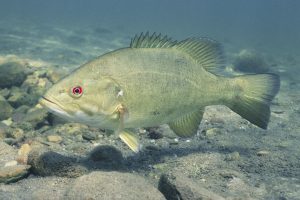Yellowstone: Invasive Bass a Real Threat to Native Fish
Written by Andrew-Rossi on March 12, 2022
Smallmouth bass is the latest aquatic invasive species threatening Yellowstone National Park, so anglers are asked to do what they do best to stop the fish.
On Wednesday, March 9, Montana Fish, Wildlife, and Parks confirmed a smallmouth bass had been caught in the Gardner River near the spot where it meets the Yellowstone River. These bass are not native species and could wreak havoc on Yellowstone’s native fish if they infiltrate the park.
Yellowstone National Park released a statement on the harrowing discovery later that day.
“Smallmouth bass are an invasive predatory species that will threaten our wild and native trout populations if they become established in the upper Yellowstone River,” the statement reads.
This year, anglers planning to fish in Yellowstone have been assigned a critical mission: catch, kill, and report all smallmouth bass.
Anglers have consistently proven their effectiveness in combatting invasive fish. For example, the ongoing and successful effort to remove rainbow trout from Yellowstone Lake has succeeded in part because of the persistence and cooperation of anglers.
This year, Yellowstone requires all anglers to participate in their urgent effort to stop the spread of smallmouth bass.
“Since anglers are highly effective at suppressing invasive fish in waters where they coexist with native species such as cutthroat trout, they will be required to kill and report any smallmouth bass caught in Yellowstone National Park when the fishing season opens Memorial Day weekend. ”
Additionally, Yellowstone National Park and biologists with the U.S. Geological Survey will be sampling the Gardner and Yellowstone rivers, upstream of where the invasive smallmouth bass was caught. Biologists will monitor these rivers closely to gauge the possible extent of the invasion over the next few weeks.
Preserving Yellowstone National Park and the Greater Yellowstone Ecosystem is of the utmost importance, not only for native wildlife but the growing tourism economies in Wyoming, Montana, and Idaho.
Time and the cooperation of anglers will significantly impact the effort to stop smallmouth bass.
Aquatic invasive species continue to be an ominous threat to Yellowstone.
Last June, an A.I.S. inspection at Grant Village found quagga mussels on a contaminated boat. Fortunately, the boat was intercepted and decontaminated the boat before it launched into Yellowstone Lake, which remains free of zebra and quagga mussels.
In 2021, Wyoming Game and Fish did the highest number of decontaminations since the A.I.S. program was established in 2010. Last year was also the first-time live mussels have been found on boats at Wyoming checkstations.
Other aquatic invasive species like curly pondweed, Asian carp, and zebra & quagga mussels have yet to establish themselves in Wyoming – but it’s getting harder to keep them out.
Hopefully, smallmouth bass haven’t and won’t become endemic in Yellowstone National Park.
“Our goal is to protect native fish populations and natural ecosystems,” the Yellowstone statement reads. “We will do everything in our power to prevent the establishment of smallmouth bass in the park and prevent them from preying on and displacing trout and other native fish.”


